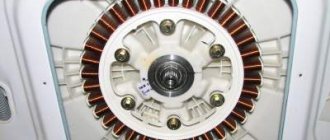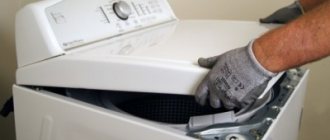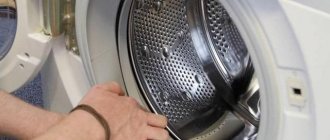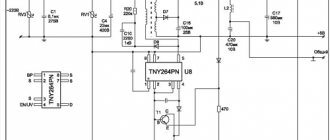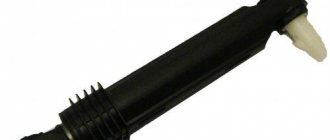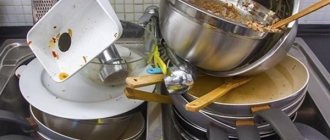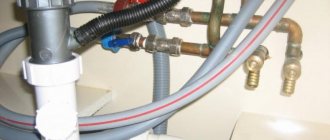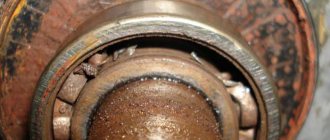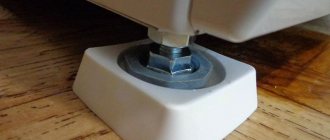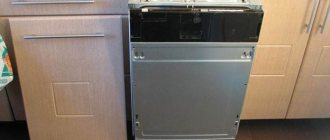A dishwasher is not as complicated a piece of equipment as it seems at first glance. Most breakdowns are caused by simple reasons. Eliminating them does not require high qualifications or special knowledge. If the equipment is no longer under warranty, you can try to repair it yourself. We will describe the main malfunctions of dishwashers and how to eliminate them further. In most cases, the causes and methods of elimination do not depend on the brand of the machine. Bosch, Siemens, Samsung, Electrolux, Miele, Indesit, Candy, Beko - it doesn’t matter. The repair is the same. The disassembly process, fastening, etc. may differ. But the basic principles of finding the causes and troubleshooting dishwashers are the same.
A dishwasher is every housewife's dream
Dishwasher device
The design of household dishwashers is in many ways similar to the design of washing machines. The main difference is that the dishwasher does not have a rotating drum and the presence of a number of specific functions that ensure the dishwashing process.
Types of household dishwashers in the photo
[wonderplugin_gridgallery id=”18″]
You can get acquainted with the internal structure of the dishwasher by opening its front wall. The list of main units and components of the unit includes:
- Control Panel.
- Board with processor.
- Electric motor.
- Dispenser.
- Dryer air path.
- Turbofan.
- Upper and lower baskets.
- Cutlery basket.
- Upper and lower rocker arms.
- Pressure pump.
- Filter system and softener.
- Drip pan and drainage.
- heating element.
- Counterweight.
- Capacitor.
- Water supply valve.
- Upper and lower (side) sprayers.
- Container for detergents.
- Float regulator.
- Ion exchanger.
- Container for salt.
Dishwasher interior
The basis of the dishwasher is a sealed metal case, coated on the inside with a stainless steel compound, insensitive to temperature fluctuations and the aggressive effects of detergents and equipped with sound and thermal insulation. The control panel is located on the front wall of the machine. It consists of a timer (microcontroller), control buttons and an indicator display.
Dishwasher control panel
Spray blocks (impeller) consist of a system of tubes and spray nozzles. Through them, heated water with detergent is supplied under pressure into the interior of the machine, which ensures high quality cleaning and washing of dishes.
Dishwasher impeller sprayer
The dishwasher float switch is the main means of protection against leakage. The drainage unit has a design similar to the drainage in washing machines.
And one of the main components of the dishwasher is the water pump, which is installed together with the electric motor. The filtration system is no less important - it serves to catch food debris and other debris.
Basic faults
Doesn't turn on
- Faulty wires, plugs, sockets. Damage to the dishwasher wires or plug may cause the dishwasher to shut down or short out. If kinks, breaks or breakage of the fork is detected, they need to be replaced, which you can do yourself or call a specialist. In order to make sure that the outlet is working properly, you need to plug in another device: an iron or a kettle.
- Malfunction of the surge protector located inside the housing. Damage or burning of the contacts in the surge protector leads to the dishwasher turning off, the housing receives an electric current, the plugs “fly out” and the RCD turns off. The element can only be replaced as a whole, it cannot be repaired.
- The buttons on the control panel are broken, do not press, dangle or sink when pressed. It is necessary to disassemble the front panel of the dishwasher and check the bolts and latches on the back side. If the fasteners break and the pushers fly out, the buttons must be replaced or the control module must be reflashed. Repairs cannot be carried out without calling a specialist.
- The control module is faulty - the LEDs do not light up and there is no indication, there is no response to pressing buttons. Most often you have to replace the assembled module; repairing electrical boards is usually not economically feasible, but you can try.
- There is no switching on due to chafing of the wires in the housing. Damage to the wiring inside the dishwasher can cause not only a failure to turn on, but also a short circuit. It is difficult to fix the problem yourself, since the entire equipment must be disassembled.
Does not heat or overheats
- The heating element has burnt out. To check or repair the heating element, you need to turn the device over, remove the back wall and visually check the heating element, having first removed it. We recommend ringing the heating element using a tester. You can replace the element yourself, since it is considered a consumable item.
- The power contacts on the control board are burnt. If the contacts are faulty, the on-board computer of the dishwasher does not transmit the command to heat the water. Sometimes mechanical cleaning of the contacts is enough to restore functionality.
- Problems with the thermostat or temperature sensor. For diagnostics, the disconnected and freed from the baskets PMM is disassembled, dismantling the lower sprinkler and debris filter. The equipment is installed upside down, the side fastenings are removed and the drain pipe is disconnected. When the bottom of the car is raised, the thermostat will be accessible, which is disconnected from the wires. You can test the thermostat and try cleaning the contacts. If the tester shows a breakdown of the temperature sensor, it is replaced. If possible, additionally check the wiring leading to the thermostat.
- If the water overheats, the control unit or temperature sensor is faulty.
Doesn't drain water
- The garbage filter is clogged. Residues from the dishes gradually collect in the filter cavity, preventing normal water circulation. To normalize operation, it is necessary to clean the filter. You can do this yourself.
- The drain pump is jammed or burned out. A characteristic sign is silence when the wash cycle ends and the water starts draining. The part is practically beyond repair and requires replacement entirely.
- If there is the sound of an electric motor running, but the fluid is standing still, large debris has entered the snail pipe. We disassemble and mechanically clean.
Water is not pouring
- Overfill protection is activated. When the dishwasher is empty, the overflow protection sensor may activate, which turns on the drain pump to protect against flooding. It is necessary to disconnect the PMM from the power and water supply, drain the water from the pan and clean the drain filter, dry the dishwasher with a hairdryer or leave it open for several hours. If the problem repeats, you need to call a technician - there may be a malfunction of the pump or pan.
- The inlet valve burned out - a small electromagnetic element that controls the flow of fluid. It burns out due to wear, voltage surges or clogging. Contact in cable connections between parts may also be lost. In this case, it is necessary to call a technician and replace the inlet valve.
Doesn't wash well
One of the most common problems when dishwashers break down is clogged impeller nozzles, or spray arms. If they become heavily clogged, the pressure of the flushing jets is not enough to maintain rotation and the mechanism stops.
The dishes remain dirty on one side. The spray arms are easily removed and washed with a stream of water. More details here.
Stops during operation
- The Aquastop system is activated. Some modern dishwashers are equipped with the Aquastop leak protection system. If water leaks into the dishwasher tray, the drain pump will turn on and stop operation. As a rule, the equipment reports this with a certain code on the display or by flashing indicators. To unlock the PMM, turn off the power supply, remove water from the pan and dry the internal parts of the equipment. After drying, the PMM is restarted; if the problem persists, a technician must be called.
- Another problem could be glitches or failure of the Aquastop sensor itself, which erroneously reports a leak if there is none. In this case, the sensor needs to be replaced.
- The float switch is activated. Modern dishwashers are usually equipped with a float switch to protect against overfilling. If it does not work correctly, it needs to be checked. Remove the front bottom cover, get to the pan and check the float for sticking manually. Tapping helps fix the problem. If this does not help, you need to call a technician and replace the switch.
- If the equipment often does not complete the cycle even after repairing the above-mentioned modules, the main control module is faulty.
Leaking
- Door seals are torn. If the seals are damaged or dry out, the door does not close tightly, causing water to leak from the bottom. Minor damage to the rubber does not affect the operation of the PMM in any way. Repairs are carried out by replacing the upper and then the lower seal. The equipment is disconnected from the network, the door is fully opened, and the loading trays and baskets are removed. The seal is carefully pulled out of the recess. The gutter is wiped with cotton swabs and a dry rag, then a new seal is installed, pushing the rubber bands all the way.
- Broken lock on the door. If there is no characteristic click when the door closes, the lock is most likely faulty. The door does not close tightly, causing water to leak. A breakdown should be accompanied by an error code with a corresponding indication in the form of an icon, which does not always happen. To replace the lock, de-energize the device, remove the facade and control panel, unscrew the lock and replace it with a new one.
- The door or fastening to the body is deformed. If used carelessly, the door fastening bracket can be deformed, a couple of degrees not noticeable to the eye, enough for the rubber band to begin to let water through. For diagnostics, the door is visually inspected for the presence of dents or loose fit to the PMM. We recommend replacing the mount with a new one.
The door won't close
- The lock is broken. The door does not hold or lock in the closed position. The lock can jam even when the door is open, which will not allow the PMM to be hermetically sealed. You can solve the problem one-time using a screwdriver by wedging the lock tongue, but it is better to completely replace the latch element.
- When opened, the door suddenly “falls out”. Most likely, the cable or the tensioner itself (2 small springs) broke. You can replace the tensioners yourself, but you will have to disassemble the housing. During self-repair, the old cable and spring are replaced with new ones, preferably original ones.
Burnt out intake or exhaust valve
- The inlet valve is burnt out. If the inlet valve fails, the PMM will not take in water, the part will not respond to controller commands, or, conversely, will not ensure closure of the membrane. The equipment is disconnected from the network and water supply, the bottom or base panel is removed, and the reservoir with the hose is disconnected. The reservoir is opened and the inlet valve is replaced. In some machines you won’t be able to do this yourself; you need to call a technician.
- The water discharge recirculation valve has burnt out (usually installed on expensive models, such as Bosch). If the outlet valve fails, water does not leave the PMM, error e19 lights up on the panel. The part requires replacement.
Debris gets into the main motor
If debris gets into the high-pressure motor (pump), the machine will make a characteristic noise, grinding, whistling, and the electric motor may jam, causing a hum. A burning smell appears and fuses trip. This happens due to loading dishes into the PMM that are contaminated with large food debris, such as seeds from berries and fruits. We take out the module and try to wash it, it usually helps.
The pressure switch (water pressure sensor) is broken
- The pressure sensor is broken. If the pressure sensor breaks down, continuous circulation of water occurs, there is no heating and automatic, continuous drainage of the liquid occurs. The problem can only be solved by replacing the sensor.
- When the air tube connecting the water tank and the sensor is clogged, water overflow or underfill occurs. The part requires removal and mechanical cleaning.
The turbidity sensor is clogged
A turbidity sensor, or aquasensor, allows equipment to “understand” how well the dishes have been washed by assessing the light conductivity of the water. If the surface of the aquasensor becomes clogged, the machine automatically extends the cycle without completing the wash and increases water consumption.
- If the sensor is covered with grease, you can disassemble the equipment and degrease the sensor.
- The sensor may become clogged due to salt deposits (scale) - take a screwdriver and “pick out” the hard white crust.
If mechanical cleaning does not help, we replace the module ourselves or call a technician.
No grounding
- The surge protector that protects electrical circuits from burning during power surges is broken. Damage or weakening of the contacts in the surge protector causes “glitches” in the control module, causing incorrect operation, and ultimately leading to equipment shutdown. Also, a malfunction of the SF leads to an electric shock through the housing.
- The body is electrocuted. It is necessary to fix the outlet or connect the PMM to another outlet equipped with grounding. The socket for connecting the dishwasher must be connected to the circuit breakers using a three-wire wire.
- Knocks out the circuit breaker or RCD. If there is no grounding, the circuit breaker may be knocked out due to spurious interference. Another reason may be inappropriate, old electrical wiring that requires replacement.
Doesn't dry out
- The thermal fuse of the air heating element trips. The problem appears over time when the condensation dryer housing overheats. The thermal fuse needs to be replaced, most often together with the dryer module.
- The air heating element has burned out. If the heating element fails, a burning smell may appear. A part needs to be replaced.
- The warm air circulation motor has burnt out. The problem occurs when there is a power surge, a dirty air filter, and often appears in conjunction with a broken mains filter. The assembly is changed or the winding is rewound (rarely helps and is not cost-effective).
Hoses become clogged
Do not place dishes that are excessively soiled with food debris into the dishwasher. All fat, bones and other biological residues accumulate in the pipes and hoses. To eliminate the problem, the PMM is disassembled and the hoses are cleaned manually.
Sprinkler does not spin
- Impeller clogged. Remove the nozzles and rinse the nozzles in the opposite direction under running water.
- Loss of tightness. If the impeller loses its tightness, water can fly out into the gaps that appear. Sprinklers need to be replaced.
- The secondary plastic gasket has worn out. It is necessary to remove the impeller and replace the gaskets.
- High pressure pump malfunction. If the nozzles are OK, you need to inspect the pump. If the motor hums but does not rotate, the problem is most likely in the pump. Disconnect the machine from the network, open the case, loosen the pipe clamps and disconnect the connectors. Release the latches and unscrew the mounting screws. Next, release the fastenings of the other pipes, move them to the sides and remove the pump from the housing. Now install the new motor and reassemble the structure in reverse order.
Regular dishwasher maintenance
Dishwasher maintenance: cleaning stage
Using kitchen equipment every day, you inevitably learn to distinguish how it works - properly or with some malfunctions. And not all of the latter are associated with obvious problems in the equipment itself.
If your dishwasher does its job poorly, it is quite possible that you are simply violating the operating mode.
This is evidenced by:
- White stains and drips on dishes
Streaks appear when the user has added too much rinse aid or salt. Dirty streaks indicate the opposite - in this case it is worth increasing the dosage of detergent.
Too much detergent
- Poor drainage of used water
Residues of food at the bottom of the dishwasher and on the dishes themselves are a sign of clogged filters. Manufacturers recommend cleaning them almost after every wash, after draining the remaining water from the system.
- Poor quality of cleaning dishes from food residues.
Any, even the best dishwasher is unlikely to cope with dishes that are thoroughly burnt or have not been washed for a long time - in this case, you should do a little work with your hands before loading them into the machine.
Before Loading: Manually Cleaning Burnt-Out Pans
- Excess foam
If there is too much foam, then the rinse aid is loaded far beyond normal. Just adjust the machine dispenser or add a little more powder - an excellent defoamer.
Foam residue after washing
The reasons for unsatisfactory cleanliness of dishes after washing can also be:
- improper placement of dishes in the interior of the dishwasher - water does not reach all surfaces;
Correct installation of dishes in the dishwasher - the impeller does not spin - the sprayer is blocked by excessive loading or improper installation of dishes;
- Detergent is not supplied - it has simply run out, or its supply is blocked by dishes or food debris;
- water does not flow from the impeller - you need to check the spray nozzles and, if necessary, clean them with a stream of water, after removing them from the machine;
- incorrect choice of washing mode.
DIY dishwasher diagnostics
Before you start repairing the dishwasher yourself, you need to find the problem. And the machine itself can help with this, because modern devices have a special algorithm that, when a breakdown occurs, performs self-diagnosis and presents the fault to the user in the form of a digital code.
This code will be displayed on the display of the household appliance, and on more outdated models the error is displayed in the specific activation of LED indicators. Well-known manufacturers of household appliances, such as Zanussi and Electrolux, have made the self-diagnosis process automatic - the dishwasher independently determines the malfunction and displays the code. For models from other companies, failure detection begins after entering a certain key combination. Information about the correct sequence can be found in the operating instructions.
Various error codes using the example of a dishwasher from Indesit:
- E1 – signals that the liquid is not heated. The problem is due to a malfunction of the heating element, thermostat or control module.
- E2 – pressure switch malfunction. A pressure switch is a sensor that provides the user with accurate information about the presence of water in the tank and its quantity.
- E5 – water level exceeds normal.
- E6 – Aqua Sensor does not work. This device determines the degree of water contamination. Triggers during the final rinse of items.
- E9 is the most common error that indicates a malfunction and replacement of the heating element.
- E15 is a code that signals both the activation of AquaStop and the failure of this function.
- E17 – lack of water in the dishwasher.
- E21 - there is no normal fluid circulation, the cause is a pump malfunction.
- E27 - the industrial network voltage does not correspond to the norm.
What to do if the dishwasher doesn't work well?
If you still managed to start the unit, but it is obvious that it is not working correctly or is not performing its functions, the closest attention should be paid to the following points:
- Knocks and other extraneous sounds when equipment is operating
The integrity of the nozzle bearings should be checked. The bearings of the main or drain pump unit may also knock. The first works periodically, pumping water into the system, the second - at the end of each cycle.
- Water does not enter the working chamber
If the filter and water supply hose have nothing to do with it, most likely the culprit is a broken inlet valve that needs to be replaced.
Dishwasher inlet valve
- Pressure switch does not work
You need to remove the terminals from this part and clean the pipe to which the plastic pressure tube fits - a working switch, when triggered, makes a soft click.
- The machine stops mid-cycle
The reason for this is most often a faulty pump. But first you should check the recirculation filters, water intake path, water heater or thermostat.
Dishwasher circulation pump
- Dishes are washed with cold water
Most likely, your machine does not have a temperature sensor, so its programmer did not notice that the heating element or heating automation was out of order. In this case, you will have to replace the broken electronics, which is recommended to be done at a service center.
How does a dishwasher work?
To repair a dishwasher, you need to understand the processes that occur in it. This is the only way to determine the possible causes of the breakdown and eliminate them as soon as possible.
Let us describe the general principle of operation of a dishwasher. The operating algorithm is usually the same for all manufacturers, although some changes may occur. Next, we will describe the most time-consuming process - washing dirty dishes with time to “acidify” the remaining food.
- After loading the dishes, the door closes. This is recorded by a special sensor. If the lock is not closed, the dishwasher will not start.
- The user selects the dishwasher operating mode and presses the “Start” button.
Rinse water is supplied from all sides
- The water intake valve opens and it is pumped into a special tank. Along the way, it is mixed with softening salts and detergent. The water level is controlled by appropriate sensors.
- The tank contains heating elements - heating elements. They heat the water to the required temperature (depending on the selected mode). The degree of heating is controlled by a temperature sensor. The process continues only if the sensor is triggered.
- Heated water is supplied by a circulation pump to nozzles located on the side surfaces and sprayed in small portions. This is the "soak" mode.
- The liquid draining from the dishes is collected in a tray, passes through filters, and is again supplied to the nozzles.
- At the end of the time allotted for this mode (controlled by the processor), the rinsing mode is activated.
- In this mode, water is supplied from the main sprinkler, which is located under the basket with dishes. Powerful jets of water directed in different directions wash away any remaining dirt.
- The process goes on cyclically - the water is filtered, more detergent is added to it, and it again ends up in the sprinkler. This is how the final removal of contaminants occurs. The number of cycles depends on the selected program.
Water is supplied from the nozzles under pressure
- After this mode ends (controlled by the processor), a command is given to drain the dirty water. The pump pumps it out of the reservoir.
- A small portion of water is pumped in to rinse the tank and removed again.
- Water is collected for rinsing. It is fed into a sprayer, which sprays it in different directions, washing the dishes from all sides. The rinsing process can be repeated several times.
- Waste water from the reservoir is pumped into the sewer system.
- Drying mode is activated. It all depends on the type of dishwasher. If there is a drying mode, heating elements are turned on to heat the air. Heated air is forced into the chamber using a fan. If there is no such mode, the dishwasher simply turns off - the dishes dry by convection.
As you can see, a large number of sensors are involved in the process. All of them can fail and cause a breakdown. Filters, nozzles, and sprinklers may also become clogged. All these are causes of failure.
How to dismantle and disassemble a dishwasher?
Removal and disassembly of the dishwasher must be carried out in accordance with the manufacturer's instructions.
Removing the front panel of a built-in dishwasher
Well-known brands provide more detailed information about the equipment they produce, incl. in Russian. In other cases, you will have to look for a sensible algorithm of actions on the Internet, or trust your technical instinct - after all, the dishwasher device is not super-complicated and anyone can figure it out using their ingenuity and the tools necessary for the job.
Strict adherence to operating conditions reduces the likelihood of a dishwasher breaking down by at least four times. Therefore, immediately after installation, thoroughly study the operating programs of the unit and clearly explain to your household how to use it correctly.
Water does not enter the PMM
Sometimes Beko dishwashers stop washing dishes, and the liquid intake indicator on the dashboard lights up. In such a situation, the first thing you need to do is make sure that the shut-off valve is in the open position. Then you need to check for blockages. It is also worth making sure that there is good water pressure in the main line.
Further steps to resolve the problem:
- closing the valve, disconnecting the hose from the body part. If you have Aquastop, you should carefully inspect its sponge. If the swollen absorbent blocks access to the hopper, you will need to replace the element with a new one;
- dismantling the mesh filter, cleaning it if there is debris.
If water is constantly being collected and drained, this indicates a breakdown of the solenoid valve or pressure switch (relay). The control module sends commands to the coils, and the membrane parts open slightly for subsequent fluid intake. If the elements are burned out, the valve will only remain in the closed or open state. To replace, you need to look into the block at the base of the inlet hose; the structure is located there.
The pressure switch controls the water level in the tank. When it breaks, the liquid will begin to overflow or not reach the desired volume. The sensor is located next to the dishwasher motor in a protective box from which the hose extends. It should also be checked for blockages that affect the accuracy of the relay readings.
Preventing the problem from recurring
To do this, follow these simple rules:
- monitor the hoses, do not allow kinks or pinching;
- monitor the filter - carry out preventive cleaning once a month;
- if voltage surges are observed, install a stabilizer;
- if there is a frequent drop in pressure in the pipeline, install a hydraulic station;
- use only special dishwashing detergents;
- if the water is hard, carry out preventive cleaning once a month to remove scale, or constantly use anti-salt products;
- treat the door with care, closing it carefully, preventing foreign objects from entering.
Find out everything you need to know about dishwasher water in this section.
What causes most breakdowns?
Unfortunately, in many cases dishwasher malfunctions are caused by users. Owners who do not carefully read the operating instructions create problems for themselves.
The most common causes of their occurrence are:
- incorrect connection of the PMM to the water supply, electrical network and sewerage system;
- violation of the dishwasher operating rules;
- use of detergents, salt and rinse aids not intended for these household devices.
You need to connect the dishwasher with skill or entrust this work to professionals.
If the connection to communications is incorrect, the PMM may not work. One example of installation errors is exceeding the maximum length of hoses connected to the water supply and sewerage systems. As a result, the drain pump (hereinafter also referred to as the pump) may not have enough power to pump liquid into the sewer, and water from the water supply will not flow into the tank in sufficient volume.
By placing dishes with a large amount of dried dirt into the appliance, you risk clogging the dishwasher filter.
Before washing in a PMM, the surface of the dishes must be cleaned of dried and burnt pieces of food - this is one of the important rules of operation. Otherwise, even soaking and prolonged intensive washing will not help to wash kitchen utensils well. In addition, the machine may stop working if the filters, clogged with dirt, stop passing liquid through them. Therefore, clean the filter from grease and dirt after each operating cycle and at least once a week.
If you use household chemicals that are not intended for dishwashers, this may result in poor dishwashing or damage to the unit.
The use of cheap and low-quality preparations leads to poor quality of washing and rinsing. For example, stains with a whitish tint remain on the surface. Sometimes this can cause high levels of foaming and liquid leakage into the pan, causing the dishwasher to stop working and an error code to appear on the control panel.
Abundant foam in the chamber makes it difficult to wash the utensils
In addition to the above reasons, there are also those that arise due to the fault of utility services. Eg:
- tap water hardness level is too high;
- voltage surges in the electrical network, leading to damage to electronic circuits.
If there is a large amount of salt impurities in the water, regenerative salt cannot soften the liquid to the required level. This situation leads to the appearance of lime deposits in the PMM parts and on the walls of the working chamber. The scale that forms on the surface of the flow-through electric heater (hereinafter also referred to as the heating element) does not allow it to heat the water to the required level. Limescale deposits clog the holes in the sprinkler arms, causing the cleaning quality to drop sharply.
This amount of scale is unacceptable for a dishwasher - it urgently needs to be washed with a special cleaning agent
Powerful voltage surges in the electrical network (sometimes up to 380 volts) are fraught with fatal consequences for household appliances. The control units of dishwashers suffer the most from such processes. In most cases, experienced technicians will check and replace the burnt part. But it also happens that you have to change the entire module.
Control triac in the control unit, burnt out due to surge voltage
The last cause of damage to PMM is wear of parts or defects that arise during their production. Over time, this leads to breakdown of the household appliance.
Readers can learn how a dishwasher works and what breaks in it from the following video:
Why does it hum or not make any sounds?
The dishwasher does not fill with water and is humming - this indicates a breakdown associated with the water supply path:
- the hose is clogged, bent, crushed,
- the filter is clogged,
- The supply valve does not operate due to a breakdown or blockage.
The dishwasher does not fill with water and there are no extraneous sounds - an electronic failure. "Silence" reports problems with:
- control unit,
- with water level sensor,
- aquastop or door.
Typical malfunctions of Beko washing machines
By entrusting the inspection of your car to an experienced technician, you can rest assured that he will quickly and professionally find what the problem is. But due to the high prices for services, many home craftsmen are trying to save money and repair the Beko washing machine themselves.
Almost any SMA model can be repaired at home: ELB 57001 M, RKB 58801 MA, LNU 68801, etc.
This approach is quite justified - often repairs are exorbitantly expensive, and sometimes the price is such that you can buy a new machine. At the same time, even the most “killed” car can last for several more years after repair.
Don't want to throw away your Veko machine and buy a new one? Try to figure out the problem yourself and fix everything yourself.
The design of the Beko washing machine also determines the nature of its breakdowns. Let's look at typical malfunctions of washing machines of this brand:
- The water does not heat up to the set temperatures; washing is done in cold water on any program. Or vice versa - the water overheats.
- Water slowly fills into the tank or does not fill at all.
- The Beko washing machine does not start because the hatch does not close tightly enough.
- There is water standing in the tank at the end of the wash (this may be accompanied by a strong hum).
- The rotation of the drum occurs with grinding, roaring, clanging and other uncharacteristic sounds.
- Not a single washing mode starts - all the lights on the machine blink. Or the program works, the indicator lights up, but the machine does not wash.
- It is not possible to start the machine with the power button (with the power cord plugged in).
- Models with an electronic display display error codes H1, H2, H3, H4, H5, H6 and H7. The machine doesn't work.
Important! There may be other signs of failure. We looked at the most common ones among Beko SM users in Russia.
List of provoking factors depending on the dishwasher model
All dishwashers work on the same principle. But everyone has different spare parts, different software, different “weak” points:
- Indesit - the most common problem with water intake is related to the filling system; it needs to be cleaned more often.
- For Zanussi, the weak point is the filling valve.
- Beko's water level sensor falls off more often than other models. This leads to water overflow or no water at all.
- In the second generation of dishwashers from the Bosch model range, the lack of water supply is due to an electronic control failure. The machines are very sensitive to low water pressure.
- The third generation of the Bosch model range has increased sensitivity to excess pressure. With it, the “electronic sensor” does not have time to “track” the filling of water and stops the program.
